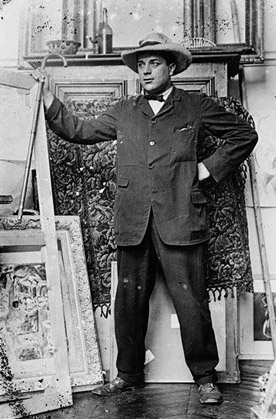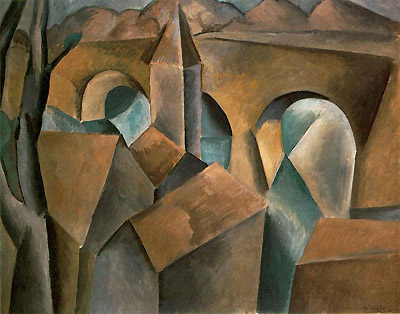In the spring of 1907, Georges
Braque visited the studio of Pablo Picasso
for the first time. In the years that followed,
the two artists, apparently so different in background,
temperament, and possibly even in aesthetic, became
essential to each other. They forged a relationship
that was part intimate friendship, part rivalry, and
part two-man expedition into the unknown. The young
men were constantly in each other’s studio, scrutinizing
each other’s work, challenging, stimulating,
and encouraging each other. They went off to paint
in different places and returned to compare results.
They invented nicknames for each other, shared jokes
and pranks, dressed up in each other’s clothes
and took photographs. Along the way, they invented
a new language of painting that shattered time-honored
conventions of representation: Cubism. |

|
The works of Paul Cézanne inspired Picasso and Braque
in the early 20th century. Particularly, they examined the fragmented
space of Cézanne’s paintings, the ambiguity of forms in
space, the ambiguity of foreground/background - of whether an object
is in from of or behind another object, objects that tended to dissolve,
leading to abstraction, and the simple forms of cubes, spheres, and
cones. African art was also influential. Picasso and Braque looked at
the simple geometric forms and masks. From these various types and components
of art, they developed the style that came to be known as Cubism.
Some important aspects of Cubism include facetted forms, a very limited
palette, and multiple views of the subject. In some of Picasso’s
portraits, you can see the frontal view and profile of the person. The
Cubist style emphasized the flat, two-dimensional surface of the picture
plane, rejecting the traditional techniques of perspective. Foreshortening,
modeling, and chiaroscuro (the arrangement of light and dark elements
in a pictorial work of art) were included, and time-honored theories
of art as the imitation of nature were refuted. Cubist painters were
not bound to copying form, texture, color, and space. Instead, they
presented a new reality in paintings that depicted radically fragmented
objects, whose several sides were seen simultaneously.
Picasso painted Les Demoiselles D’Avignon in 1908.
It was a radical departure from the artistic ideas of the preceding
ages and is now considered the most significant work in the development
of Cubism and modern art. Its fragmented forms and unprecedented distortions
are apparently inspired by the work of Cézanne and
African art. The painting began as a narrative brothel scene, with
five prostitutes and two men — a medical student and a sailor.
But the painting metamorphosed as he worked on it. Picasso painted over
the clients, leaving the five women to gaze out at the viewer with their
terrifyingly bold and apprehensive faces. There is a strong undercurrent
of sexual anxiety.
Picasso painted one of his several Self-portraits in 1907. The eyes
are staring at the audience full in the face. However, if you look at
the nose, the nose does not come down straight but appears to be turned
towards the right. This suggests a three-quarters view of the face,
which contradicts the full-face view suggested by the eyes. Also, the
eyes make such a strong impression because the left eye has been turned
round to look out full-face (in relation to the nose). This makes a
more arresting effect, not because it is arbitrary or brutal but it
is counterbalanced by the hair, head and ear being turned round towards
the front on the opposite, right-hand side.
|
|
House in a Garden (House with Trees) was painted in 1908.
The painting mostly consists of greens and cream colors. The leaves
and grass are fragmented. The tree’s branches have curves as well
as sharp angles. The house in the garden and the wall around the garden
are made of simple geometric figures.
In 1907, Picasso painted Vase, Bowl, and Lemon. Paul
Cézanne’s influence was evident in this piece. His
doctrine of Cubism during this time defined what Cubism was made of.
"Everything in nature takes its form from the sphere, cone or
cylinder." Simple geometric shapes were used. The background
tends to dissolve and the shapes on the left of the vase are indistinguishable.
Picasso used darker colors on the left side of the painting and he used
warmer colors on the right side.
In 1908, The Peasant Woman was created. The Cubist feature
of geometric shapes is found in this piece. It appears that the woman’s
head is facing downward and the top of her head faces the viewer. However,
after looking a bit more closely, the top of her head may actually be
her face. There is a shape in the middle of the head that could be her
nose and she could be wearing glasses. Her dress or skirt meets at a
point in the center and it seems that her knees and arms are bent. The
woman’s feet are rectangular and the toes are not distinct. The
background is a bit fuzzy and it is hard to tell whether the woman is
sitting on something or if she is standing. She does cast a shadow,
however, against the wall she is in front of.

Picasso painted Landscape with Bridge in the next year.
He used many different shades of brown. The pieces of rock are broken
into fragments and you can see the different textures of the rock by
the variety of brushstrokes he used. The land on top of the bridge is
also made of different pieces. The water under the bridge is hard to
distinguish from the rocks making up most of the picture. The straight
stick-like figure on the left appears to be a tree trunk.
Cubism is a highly influential visual arts style of the 20th century
that was created principally by the painters Pablo Picasso and Georges
Braque in Paris between 1907 and 1914. Cubism derived its name
from remarks that were made by the painter Henri Matisse and
the critic Louis
Vauxcelles, who scornfully described Braque's 1908 work House
at L'Ebstaque as composed of cubes. In Braque's work, the
volumes of the houses, the cylindrical forms of the trees, and the tan-and-green
color scheme are reminiscent of Paul Cézanne's landscapes, which
deeply inspired the Cubists in their first stage of development, until
1909.
It was, however, Picasso's Les
Demoiselles d'Avignon in 1907 that forecast the new style. In
this work, the forms of five female nudes became fractured, angular
shapes. As in Cézanne's art, perspective was rendered by means
of color, the warm reddish browns advancing and the cool blues receding.
The influences that Cubism gave on the other forms of art and other
artists are significant. During the years when Picasso and Braque
were developing Cubism, the movement influenced the other artists. The
movement also inspired much of modern architecture, sculptures, clothes,
and even literature.

|


